DODGE SPRINTER 2008 2.G Owners Manual
Manufacturer: DODGE, Model Year: 2008, Model line: SPRINTER, Model: DODGE SPRINTER 2008 2.GPages: 666, PDF Size: 14.11 MB
Page 331 of 666
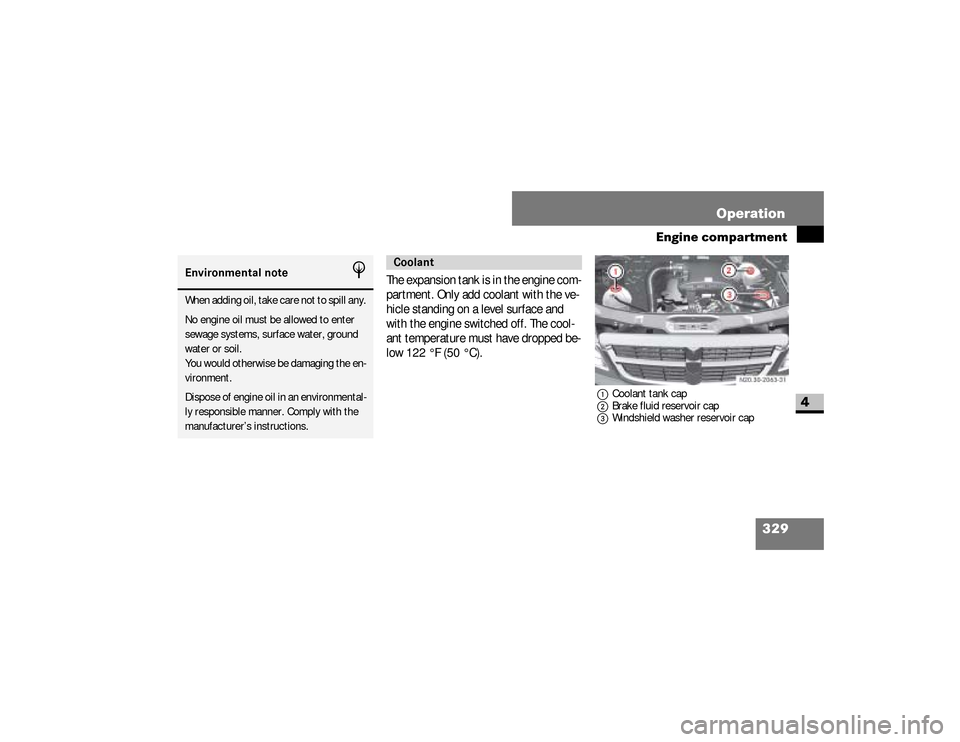
329 Operation
Engine compartment
4
The expansion tank is in the engine com-
partment. Only add coolant with the ve-
hicle standing on a level surface and
with the engine switched off. The cool-
ant temperature must have dropped be-
low 122 °F (50 °C).
1Coolant tank cap
2Brake fluid reservoir cap
3Windshield washer reservoir cap
Environmental note
H
Wh en addi n g o i l, ta ke c ar e n ot t o s pi ll a n y.
No engine oil must be allowed to enter
sewage systems, surface water, ground
water or soil.
You would otherwise be damaging the en-
vironment.
Dispose of engine oil in an environmental-
ly responsible manner. Comply with the
manufacturer’s instructions.
Coolant
N20.30-2063-31
nf_BA.book Page 329 Friday, January 25, 2008 3:53 PM
Page 332 of 666
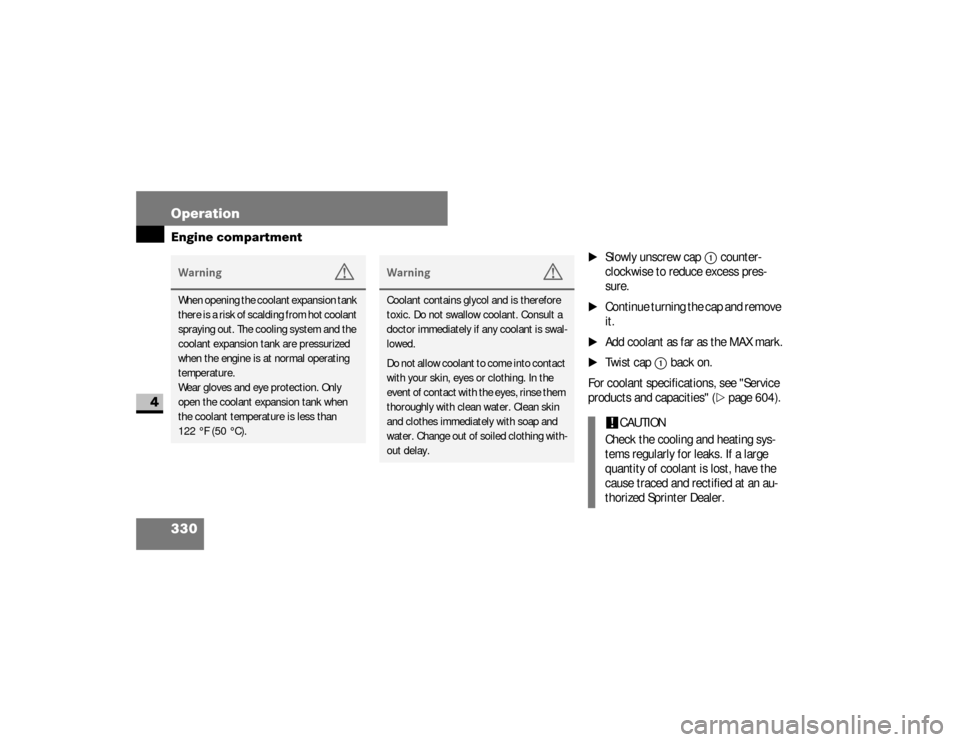
330 OperationEngine compartment
4
\1
Slowly unscrew cap
1
counter-
clockwise to reduce excess pres-
sure.
\1
Continue turning the cap and remove
it.
\1
Add coolant as far as the MAX mark.
\1
Twist cap
1
back on.
For coolant specifications, see "Service
products and capacities" (
\2
page 604).
Warning
G
When opening the coolant expansion tank
there is a risk of scalding from hot coolant
spraying out. The cooling system and the
coolant expansion tank are pressurized
when the engine is at normal operating
temperature.
Wear gloves and eye protection. Only
open the coolant expansion tank when
the coolant temperature is less than
122 °F (50 °C).
Warning
G
Coolant contains glycol and is therefore
toxic. Do not swallow coolant. Consult a
doctor immediately if any coolant is swal-
lowed.
Do not allow coolant to come into contact
with your skin, eyes or clothing. In the
event of contact with the eyes, rinse them
thoroughly with clean water. Clean skin
and clothes immediately with soap and
water. Change out of soiled clothing with-
out delay.
!
CAUTION
Check the cooling and heating sys-
tems regularly for leaks. If a large
quantity of coolant is lost, have the
cause traced and rectified at an au-
thorized Sprinter Dealer.
nf_BA.book Page 330 Friday, January 25, 2008 3:53 PM
Page 333 of 666
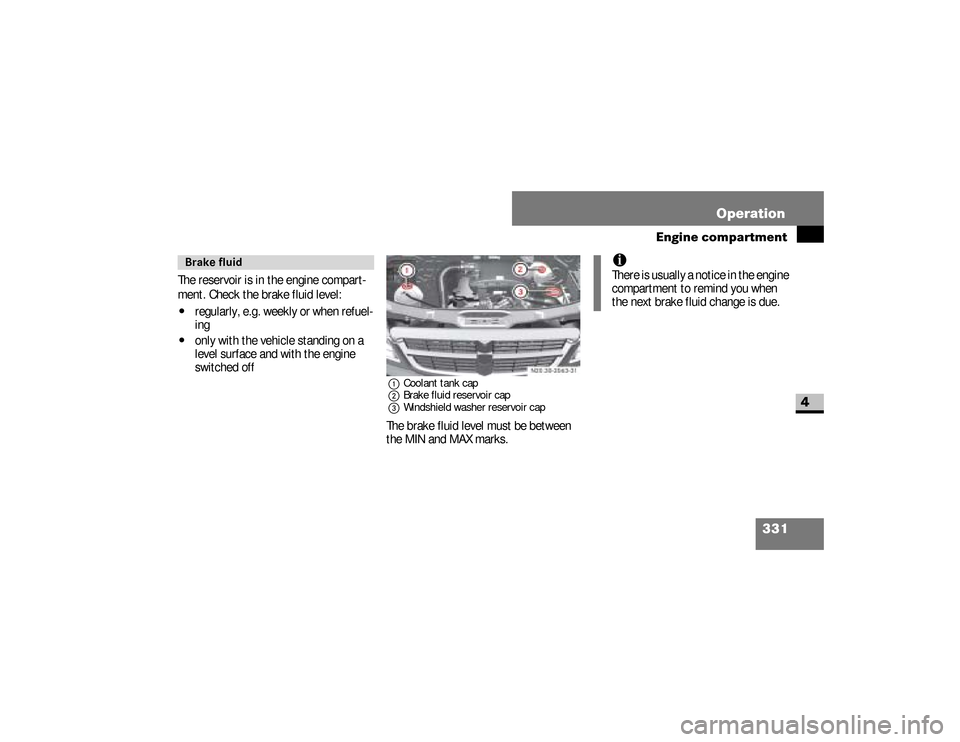
331 Operation
Engine compartment
4
The reservoir is in the engine compart-
ment. Check the brake fluid level:\4
regularly, e.g. weekly or when refuel-
ing
\4
only with the vehicle standing on a
level surface and with the engine
switched off
1Coolant tank cap
2Brake fluid reservoir cap
3Windshield washer reservoir capThe brake fluid level must be between
the MIN and MAX marks.
Brake fluid
N20.30-2063-31
iThere is usually a notice in the engine
compartment to remind you when
the next brake fluid change is due.
nf_BA.book Page 331 Friday, January 25, 2008 3:53 PM
Page 334 of 666
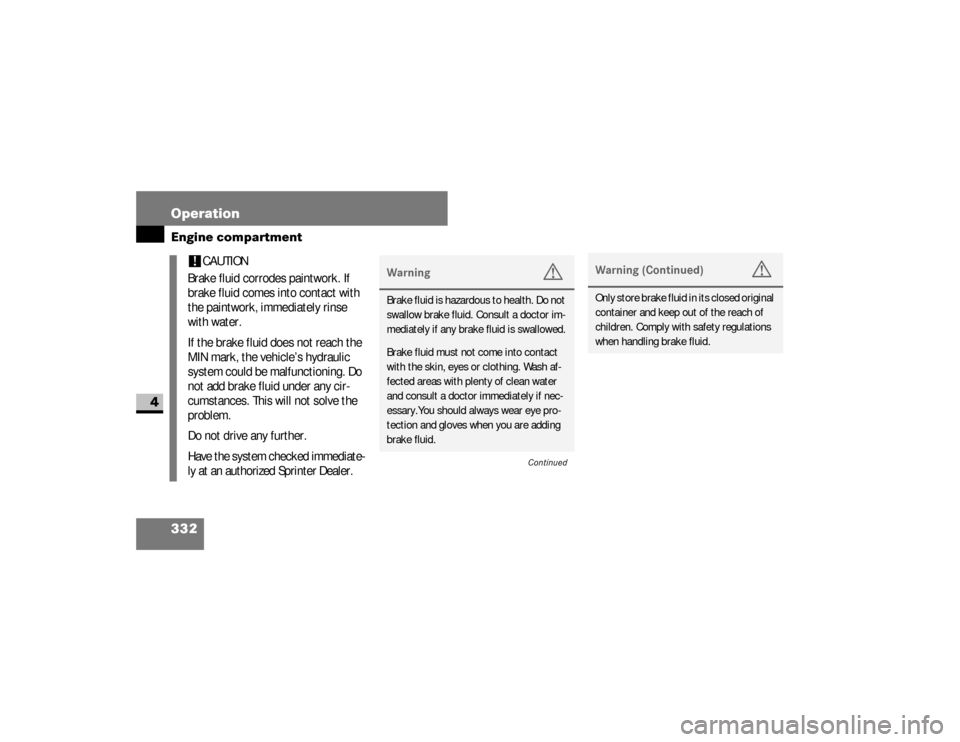
332 OperationEngine compartment
4
!
CAUTION
Brake fluid corrodes paintwork. If
brake fluid comes into contact with
the paintwork, immediately rinse
with water.
If the brake fluid does not reach the
MIN mark, the vehicle’s hydraulic
system could be malfunctioning. Do
not add brake fluid under any cir-
cumstances. This will not solve the
problem.
Do not drive any further.
Have the system checked immediate-
ly at an authorized Sprinter Dealer.
Warning
G
Brake fluid is hazardous to health. Do not
swallow brake fluid. Consult a doctor im-
mediately if any brake fluid is swallowed.Brake fluid must not come into contact
with the skin, eyes or clothing. Wash af-
fected areas with plenty of clean water
and consult a doctor immediately if nec-
essary.You should always wear eye pro-
tection and gloves when you are adding
brake fluid.
Continued
Warning (Continued)
G
Only store brake fluid in its closed original
container and keep out of the reach of
children. Comply with safety regulations
when handling brake fluid.
nf_BA.book Page 332 Friday, January 25, 2008 3:53 PM
Page 335 of 666
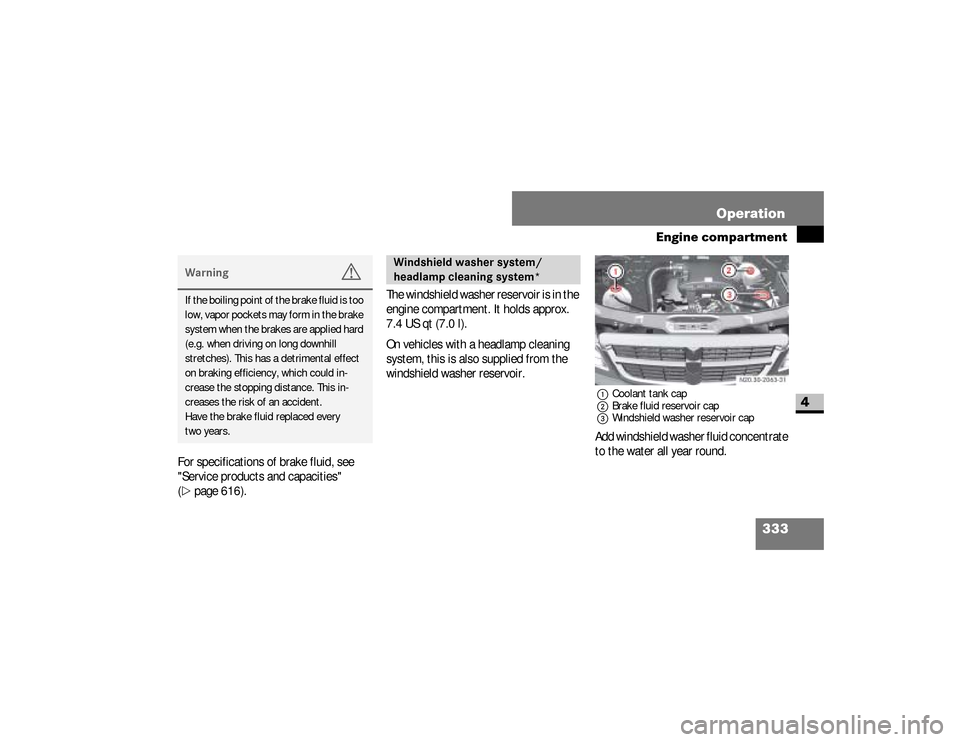
333 Operation
Engine compartment
4
For specifications of brake fluid, see
"Service products and capacities"
(\2
page 616).The windshield washer reservoir is in the
engine compartment. It holds approx.
7.4 US qt (7.0 l).
On vehicles with a headlamp cleaning
system, this is also supplied from the
windshield washer reservoir.
1Coolant tank cap
2Brake fluid reservoir cap
3Windshield washer reservoir capAdd windshield washer fluid concentrate
to the water all year round.
Warning
G
If the boiling point of the brake fluid is too
low, vapor pockets may form in the brake
system when the brakes are applied hard
(e.g. when driving on long downhill
stretches). This has a detrimental effect
on braking efficiency, which could in-
crease the stopping distance. This in-
creases the risk of an accident.
Have the brake fluid replaced every
two years.
Windshield washer system/
headlamp cleaning system*
N20.30-2063-31
nf_BA.book Page 333 Friday, January 25, 2008 3:53 PM
Page 336 of 666
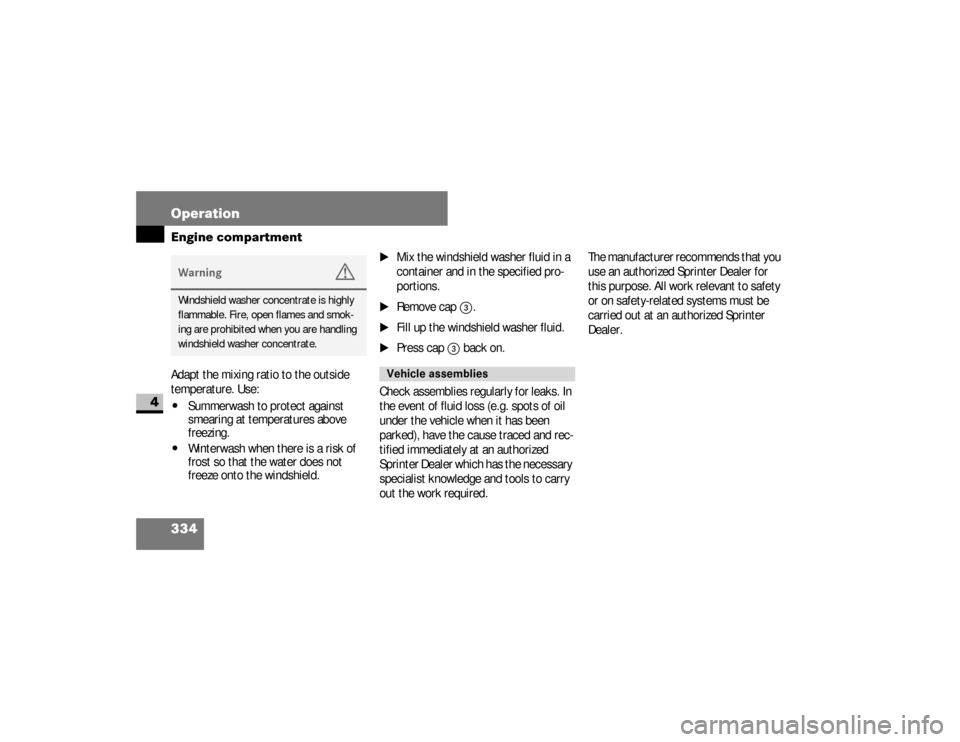
334 OperationEngine compartment
4
Adapt the mixing ratio to the outside
temperature. Use:\4
Summerwash to protect against
smearing at temperatures above
freezing.
\4
Winterwash when there is a risk of
frost so that the water does not
freeze onto the windshield.
\1
Mix the windshield washer fluid in a
container and in the specified pro-
portions.
\1
Remove cap
3
.
\1
Fill up the windshield washer fluid.
\1
Press cap
3
back on.
Check assemblies regularly for leaks. In
the event of fluid loss (e.g. spots of oil
under the vehicle when it has been
parked), have the cause traced and rec-
tified immediately at an authorized
Sprinter Dealer which has the necessary
specialist knowledge and tools to carry
out the work required.The manufacturer recommends that you
use an authorized Sprinter Dealer for
this purpose. All work relevant to safety
or on safety-related systems must be
carried out at an authorized Sprinter
Dealer.
Warning
G
Windshield washer concentrate is highly
flammable. Fire, open flames and smok-
ing are prohibited when you are handling
windshield washer concentrate.
Vehicle assemblies
nf_BA.book Page 334 Friday, January 25, 2008 3:53 PM
Page 337 of 666
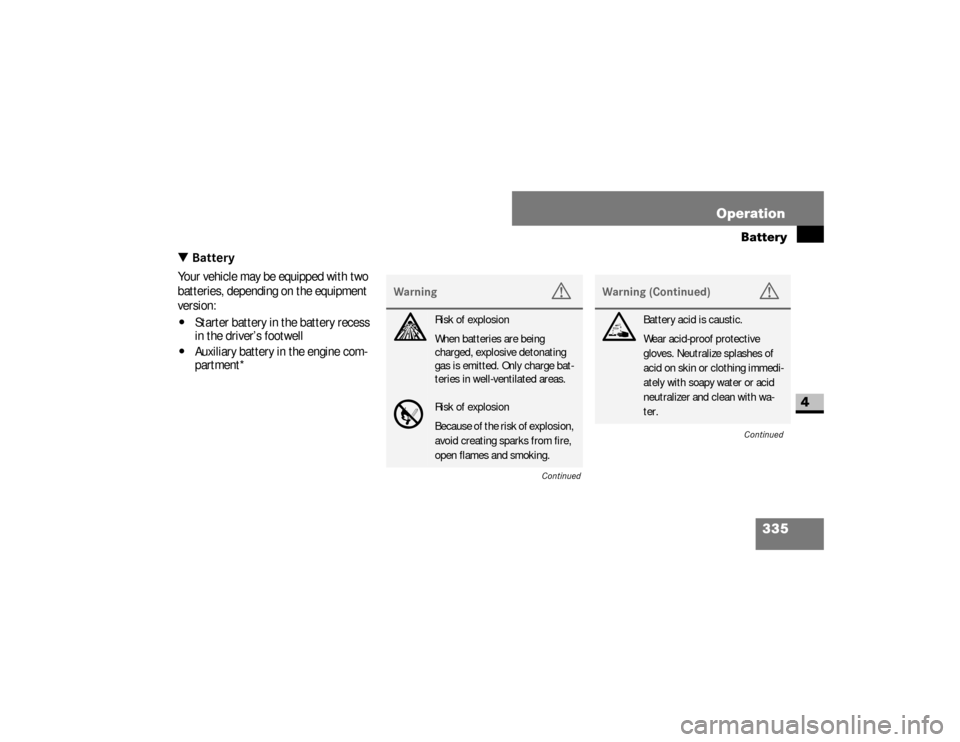
335 Operation
Battery
4
\3 BatteryYour vehicle may be equipped with two
batteries, depending on the equipment
version:\4
Starter battery in the battery recess
in the driver’s footwell
\4
Auxiliary battery in the engine com-
partment*
Warning
G
A
Risk of explosion
When batteries are being
charged, explosive detonating
gas is emitted. Only charge bat-
teries in well-ventilated areas.
D
Risk of explosion
Because of the risk of explosion,
avoid creating sparks from fire,
open flames and smoking.
Continued
Warning (Continued)
G
B
Battery acid is caustic.
Wear acid-proof protective
gloves. Neutralize splashes of
acid on skin or clothing immedi-
ately with soapy water or acid
neutralizer and clean with wa-
ter.
Continued
nf_BA.book Page 335 Friday, January 25, 2008 3:53 PM
Page 338 of 666
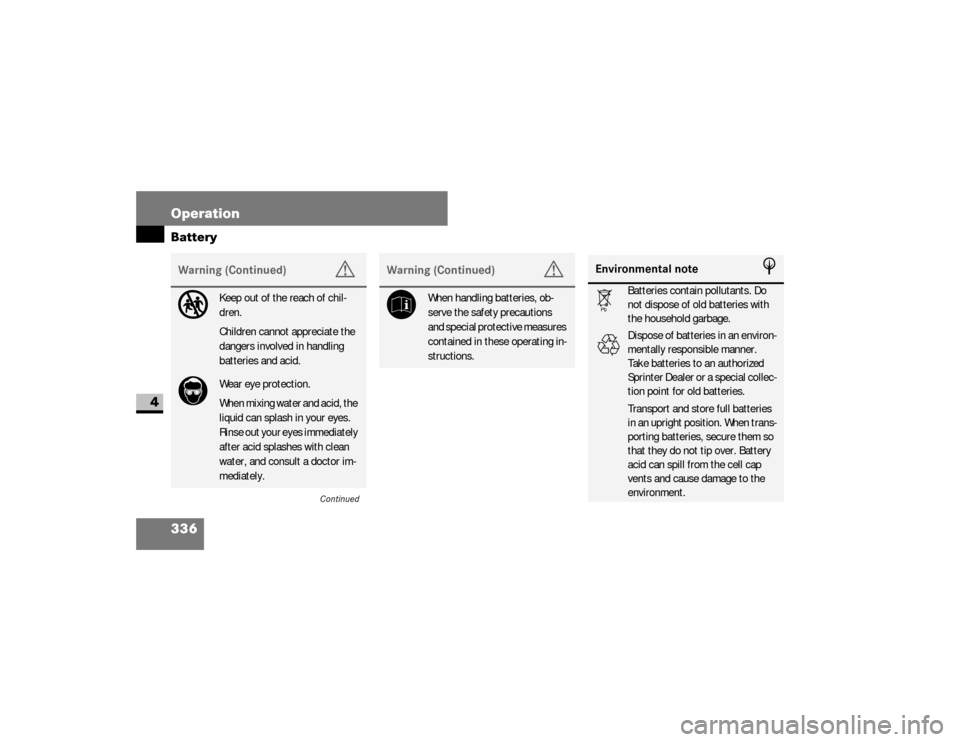
336 OperationBattery
4
Warning (Continued)
G
C
Keep out of the reach of chil-
dren.
Children cannot appreciate the
dangers involved in handling
batteries and acid.
E
Wear eye protection.
When mixing water and acid, the
liquid can splash in your eyes.
Rinse out your eyes immediately
after acid splashes with clean
water, and consult a doctor im-
mediately.
Continued
Warning (Continued)
G
F
When handling batteries, ob-
serve the safety precautions
and special protective measures
contained in these operating in-
structions.
Environmental note
H
Á
Batteries contain pollutants. Do
not dispose of old batteries with
the household garbage.
À
Dispose of batteries in an environ-
mentally responsible manner.
Take batteries to an authorized
Sprinter Dealer or a special collec-
tion point for old batteries.
Transport and store full batteries
in an upright position. When trans-
porting batteries, secure them so
that they do not tip over. Battery
acid can spill from the cell cap
vents and cause damage to the
environment.
nf_BA.book Page 336 Friday, January 25, 2008 3:53 PM
Page 339 of 666
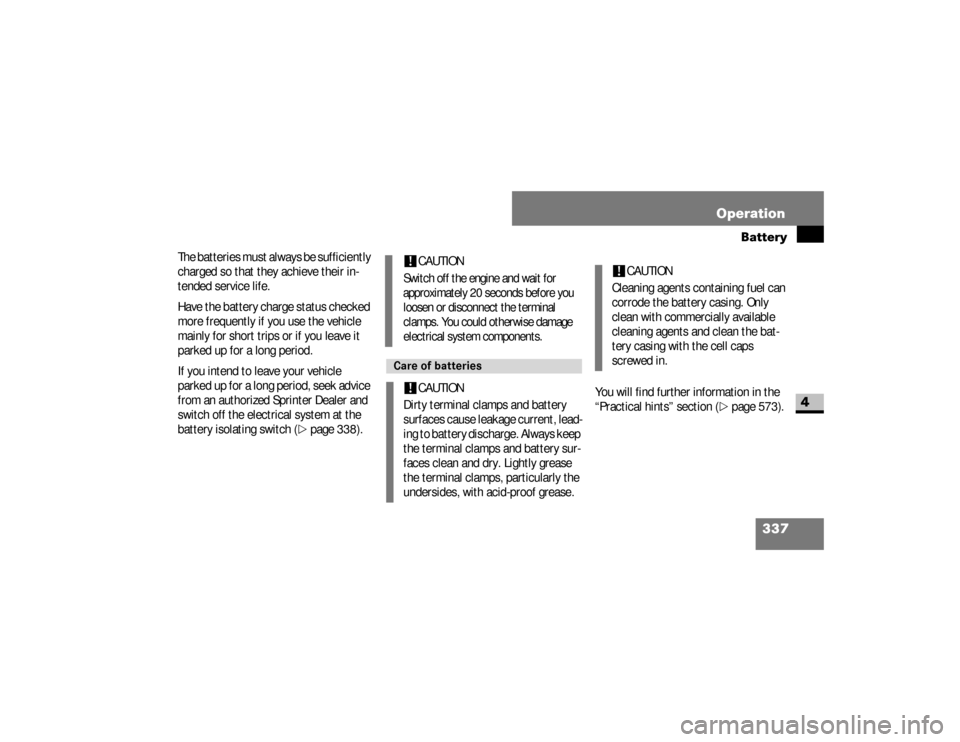
337 Operation
Battery
4
The batteries must always be sufficiently
charged so that they achieve their in-
tended service life.
Have the battery charge status checked
more frequently if you use the vehicle
mainly for short trips or if you leave it
parked up for a long period.
If you intend to leave your vehicle
parked up for a long period, seek advice
from an authorized Sprinter Dealer and
switch off the electrical system at the
battery isolating switch (
\2
page 338).You will find further information in the
“Practical hints” section (
\2
page 573).
!
CAUTION
Switch off the engine and wait for
approximately 20 seconds before you
loosen or disconnect the terminal
clamps. You could otherwise damage
electrical system components.Care of batteries!
CAUTION
Dirty terminal clamps and battery
surfaces cause leakage current, lead-
ing to battery discharge. Always keep
the terminal clamps and battery sur-
faces clean and dry. Lightly grease
the terminal clamps, particularly the
undersides, with acid-proof grease.
!
CAUTION
Cleaning agents containing fuel can
corrode the battery casing. Only
clean with commercially available
cleaning agents and clean the bat-
tery casing with the cell caps
screwed in.
nf_BA.book Page 337 Friday, January 25, 2008 3:53 PM
Page 340 of 666
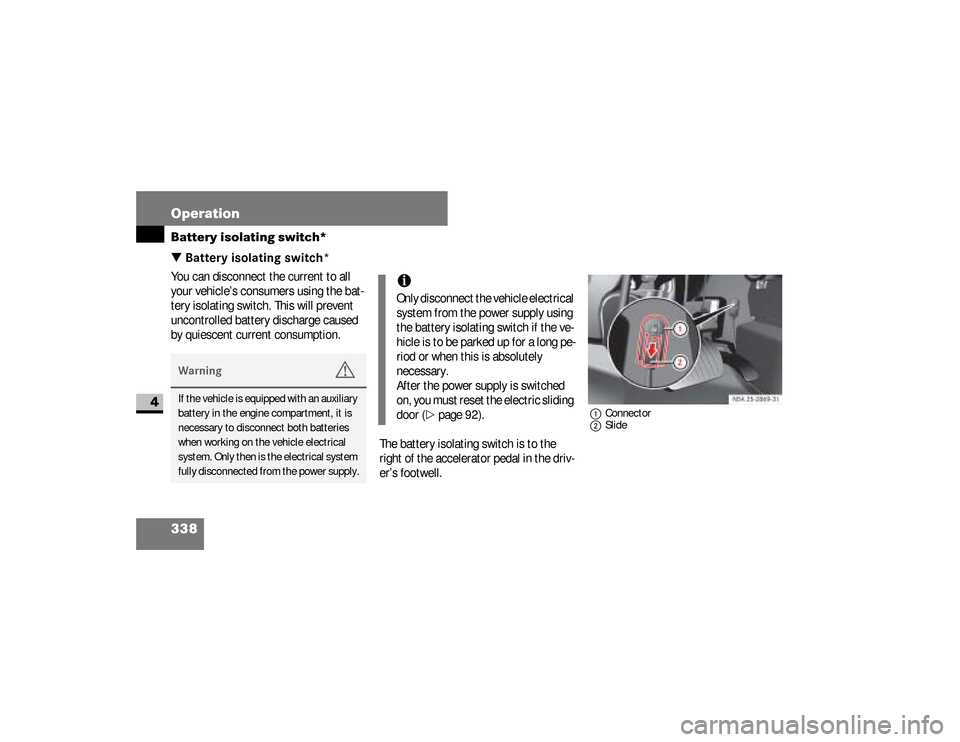
338 OperationBattery isolating switch*
4
\3 Battery isolating switch*You can disconnect the current to all
your vehicle’s consumers using the bat-
tery isolating switch. This will prevent
uncontrolled battery discharge caused
by quiescent current consumption.
The battery isolating switch is to the
right of the accelerator pedal in the driv-
er’s footwell.
1Connector
2Slide
Warning
G
If the vehicle is equipped with an auxiliary
battery in the engine compartment, it is
necessary to disconnect both batteries
when working on the vehicle electrical
system. Only then is the electrical system
fully disconnected from the power supply.
iOnly disconnect the vehicle electrical
system from the power supply using
the battery isolating switch if the ve-
hicle is to be parked up for a long pe-
riod or when this is absolutely
necessary.
After the power supply is switched
on, you must reset the electric sliding
door (
\2
page 92).
nf_BA.book Page 338 Friday, January 25, 2008 3:53 PM